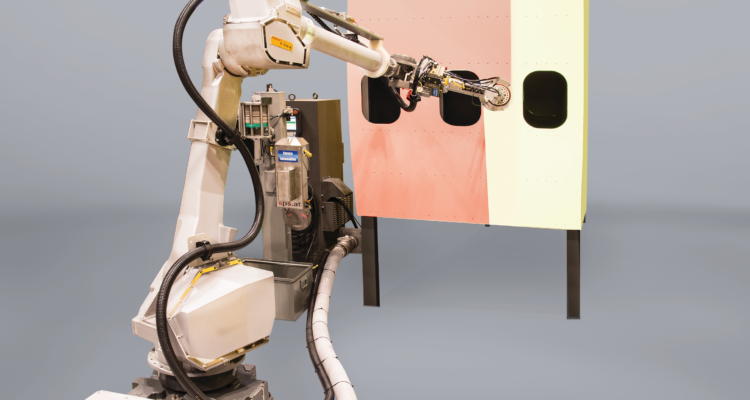Finding a Good Balance
During the blade lay-up stage, TPI usually applies a gel coat to the surface of the mold to reduce pin-holing on the blade surface and to prevent the cured material from sticking in and damaging the mold. But the gel coat leaves a glossy finish on the blades.
“It’s a terrible surface for adhering paint to, so if we’re going to get our coatings to adhere, we have to scuff-sand the surface to make it ready for painting,” Nolet says. “That’s another process that lends itself to different forms of automation, either human-assisted automation using different tools that can quickly scuff the surface or robots that can perform a compliant sanding operation.”
The blades then go into a painting booth where robot sprayers, or people using rollers or high-velocity, low pressure sprayers, apply a primer and a finishing coat. The improvement of all-in-one coating systems, where the primer and the topcoat can be applied in a single application, could save time in this area of finishing, Nolet says.
It’s around this time that technicians tie out the lighting protection system. Metallic receptors and cables that act as lightning rods are molded into the blade and must be connected to one of the root studs to be effectively grounded.
The last step, the balancing of the blades, involves adjusting the mass and center of gravity on the three blades that will be installed on the same turbine to ensure that they are consistent. If the blades aren’t balanced, the turbine won’t operate properly.
Each blade has balance boxes installed during the molding process. There are usually two or three distributed at the blade root and the tip. After measuring the mass of the blade (using two load cells) and determining its center of gravity, technicians add sand with epoxy to the balance boxes to reach the desired mass moment of inertia. The amount of this mixture and where it is placed are carefully calculated.
“We’re balancing the blades very closely,” says Nolet. “If the center of gravity is off by even 100 millimeters that will make a difference in the swing weight and the balance.”
Once the blade is balanced, inspectors give it a quality check – the last of many that have been performed throughout the entire manufacturing process. The blade then receives a decal or a stencil with the manufacturer’s name and a serial number.
The Future of Finishing
At most of TPI’s manufacturing factories, half of the space is dedicated to molding operations and the other half to finishing. When operating 24 hours a day, five days a week, a four mold-set factory will produce 20 blades per week – or about 1,000 blades per year, based on the desired 24-hour molding cycle.
The capacity of the plant is dictated by the speed of the lay-up, assembly and demolding processes, which take about 24 hours in elapsed time per mold set. The finishing stages take about twice as long in elapsed time, and there may be 10 to 15 blades in the finishing queue at any time, says Nolet.
“From the start of the molding of the blade to the time it rolls out as delivered is about 72 hours,” he says. Automation could speed up that process. The development of 3D models will help manufacturers improve the accuracy of blade assembly, and the adoption of robotic systems for finishing will become more widespread as those systems become more capable.
But automation brings its own challenges. Product cycles today are short, and blade shapes frequently change. If a wind turbine manufacturer only wants 500 blades of a particular design, it’s difficult for blade producers to justify the cost and time it would take to implement an automated setup. Robotic manufacturers are looking at ways to make their systems more adaptable to different designs, Nolet says.
Another challenge is planning for the space required by the automation technology. That must be done early in the plant design to incorporate it into the process flow. If a new automated system calls for a bridge crane, it’s usually not possible to retrofit an existing plant to accommodate it.
The changeover to increased automation in finishing will be gradual, Nolet adds. “You won’t see the difference in the next six months, but you will see that difference over the course of years, another couple of generations of product cycles. I think there’ll be more effective automation being employed because of the response of system integrators to improve the adaptability of robotic systems.”
Mary Lou Jay is a freelance writer based in Timonium, Md. Email comments to mljay@comcast.net.


